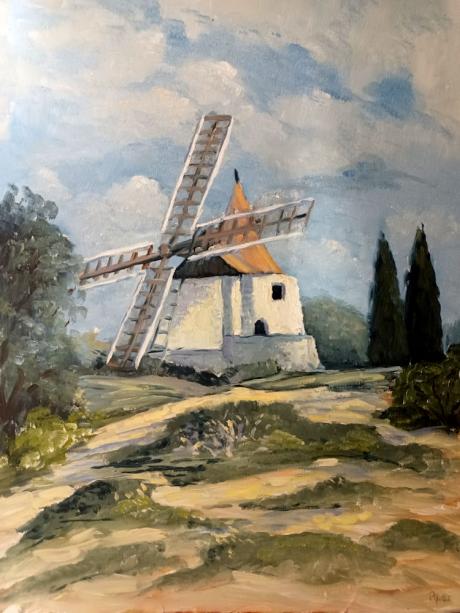" P Yates" and further inscribed on the reverse
Symbol of the writer Alphonse Daudet and his work, the Moulin is open to visitors in Fontvielle. Recently renovated, it has a very nice Museum showing works and memories of Alphonse Daudet in its basement.
Its real name was in fact "Ribet" but it was also baptised "Saint Pierre". It was built in 1815 and continued grinding during a whole century.
During the 1st World War most men were drafted and the wheat was requisitioned. These events condemned definitively our last windmill.
In 1935 the association "Alphonse Daudet's friend" decided to restore it and create a museum dedicated to the author of the "Letters of my Windmill". This building became the symbol of the writer and his work.
Letters from My Windmill (French: Lettres de mon moulin) is a collection of short stories by Alphonse Daudet first published in its entirety in 1869. Some of the stories had been published earlier in newspapers or journals such as Le Figaro and L'Evénement as early as 1865.
The stories are all told by the author in the first person, typically addressing a Parisian reader. The author, having relocated his home from Paris, recounts short bucolic tales about his new life in Provence as well as his trips to Corsica and French Algeria. The stories vary from day-to-day events in southern France to Provençal folktales, and often feature professions and faunal references characteristic of Provence. The tales are characterised by pity, tenderness and sadness, alongside gaiety and mockery.
Letters From My Windmill is sometimes considered to be Daudet's most important work. It is cherished by many French, particularly in the South, for the picture it paints of the local culture. A French-language film with the same title was made in 1954 by Marcel Pagnol composed of four stories: "The Three Low Masses", "The Elixir of Father Gaucher", "The Priest of Cucugnan" and "The Secret Of Master Cornille".
Originally from Nîmes, this young Parisian journalist returned to the south of France driven by the desire to rediscover an atmosphere, an ambiance that he thought he had lost in the capital of culture and the arts that Paris represented. He was also driven by the invitation of one of our most prestigious writers, one of the seven legendary founders of the “Félibrige”, Frédéric Mistral, who welcomed him very warmly in Maillane.
Then he came to stay at Montauban Castle in Fontvieille during the summer of 1860, hosted by his cousin Louis and his wife Octavie Daudet (born Ambroy). Ever since, he would come to Fontvieille on summer holidays, the village being a true land of inspiration for the characters of his works. The last time he came to Fontvieille was in the winter of 1891, when he came to see his dear friend Timoléon Ambroy, who was very ill.
This man’s charisma, and probably the way he described his beloved Provence with his southern accent, encouraged the young Daudet to return to our region. First, he made a long stopover in Maillane, warmly welcomed by Mistral and the ever-growing circle of “félibres”. Another invitation, this time from his cousin Louis and his young wife Octavie Daudet (née Ambroy), forced him to leave his new friends for Fontvieille and Montauban Castle.

